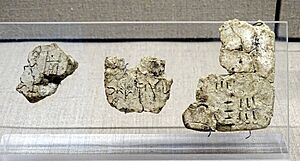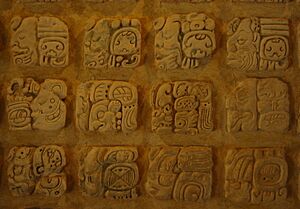Recorded history facts for kids
Recorded history is all the past events that people have written down or documented. Historians study these records using special methods to understand what happened. For the whole world, recorded history generally starts around 4000 BC. This is when people first invented writing systems.
For some places or cultures, written history only covers a short time. This is because they didn't use writing much. Also, ancient people didn't always write down everything that historians today find important. For example, they might not have recorded the full impact of natural disasters or the names of everyone involved in an event. So, what we know from recorded history depends on the types of records that were kept.
Historians use a special set of rules called the historical method. This helps them use primary sources (first-hand records) and other clues to research and write about the past. Studying different historical methods is called historiography. It looks at how different historians interpret the same evidence in different ways.
Contents
Before Written Records
Prehistory is the time before people started writing things down. It ends when writing systems were invented. If a culture didn't have writing, or if we can't understand their writing, that period is considered prehistory for them.
Protohistory is a special time between prehistory and history. It's when a society learns to read and write, but before they have their own historians. It can also mean a time when one culture doesn't have writing, but other cultures write about them.
Before full writing systems, there was something called proto-writing. These were early symbols that weren't quite full writing. Some examples include the Jiahu symbols from around 6600 BCE and Vinča signs from about 5300 BCE.
Historians sometimes disagree on when proto-writing became "true writing." But the first real writing systems appeared around the same time as the Bronze Age. This was in the late Neolithic period, around the late 4th millennium BCE. The Sumerian cuneiform and Egyptian hieroglyphs are thought to be the earliest writing systems. They developed from older symbol systems between 3400 and 3200 BCE. The first clear texts from these systems appeared around 2600 BCE.
Early Historical Accounts
The very first timelines come from ancient civilizations like Early Dynastic Period of Egypt, Mesopotamia, and the Sumerians. These civilizations appeared on their own around 3500 BCE. The earliest recorded history often talks about Pharaohs and their reigns in ancient Egypt. Many of these old records were found again recently through archaeological digs. Different parts of the world developed their own ways to understand these ancient stories.
History in Europe
Early Greek historians like Herodotus (born 484 BCE) are often called the "father of history." He wrote The Histories between 450 and 420 BCE. However, his friend Thucydides (around 460 BCE – 400 BCE) is known for being the first to use a more scientific method for history. He wrote History of the Peloponnesian War.
Unlike Herodotus, Thucydides believed history was shaped by human choices and actions, not by gods. He looked for causes and effects. History became a popular type of writing in later Greek and Roman times, with authors like Polybius and Tacitus.
During the Middle Ages and Renaissance, history was often studied from a religious point of view. Around 1800, the German philosopher Georg Wilhelm Friedrich Hegel brought a more secular (non-religious) approach to studying history.
From about 1000 CE onwards, more written records survived in Western history than any other type of source. In the 17th and 18th centuries, especially in France and Germany, historians started looking closely at these old records. They wrote histories that often had strong political ideas. In the 20th century, academic historians began to move away from grand stories about nations or "great men." Instead, they tried to analyze social and intellectual forces more objectively. A big change in the 20th century was treating history more like a social science than an art. French historians from the Annales School used data to study the lives of everyday people. They also helped establish cultural history.
History in East Asia
The Zuo zhuan, written in the 5th century BCE, tells stories about China from 722 to 468 BCE. The Book of Documents is one of the oldest Chinese texts and an early story of China. The Spring and Autumn Annals is an official record of the State of Lu from 722 to 481 BCE. It's traditionally linked to Confucius (551–479 BCE).
Sima Qian (around 100 BCE) was the first person in China to set the standard for professional historical writing. His huge work, Records of the Grand Historian, covered history back to the 16th century BCE. It included essays on different topics, biographies of important people, and even stories about common people. His work influenced every historian in China after him.
History in South Asia
In Sri Lanka, the oldest historical text is the Mahavamsa (around 5th century CE). Buddhist monks kept records of Sri Lankan history starting from the 3rd century BCE. These records were put together into one document in the 5th century. It was based on older writings called Atthakatha. An earlier document, the Dipavamsa (4th century CE), is simpler and has less information.
A related book, the Culavamsa, covers the period from the 4th century until the British took over Sri Lanka in 1815. Many different authors wrote parts of the Culavamsa over time.
Together, the Mahavamsa and Culavamsa create a continuous historical record of over two thousand years. It's one of the world's longest unbroken historical accounts. These books also contain information about the Nāga and Yakkha people, who lived in Lanka before Prince Vijaya arrived.
The Sangam literature gives us a look into ancient South Indian culture. It talks about beliefs and people. For example, a poem from the Sangam era mentions the "pigtail of Brahmin boys." These poems also hint at historical events, ancient Tamil kings, and the effects of war. The Pattinappalai poem describes the Chola capital, King Karikala, life in a harbor city, and the worship of the Hindu god Murugan.
Indica is a book about Mauryan India written by the Greek writer Megasthenes. The original book is lost, but parts of it survived in later Greek and Latin writings.
History in West Asia
In his book Muqaddimah (1377), the Arab historian Ibn Khaldun warned about seven common mistakes historians made. He saw the past as something strange that needed careful interpretation. Ibn Khaldun often criticized "lazy superstition and accepting historical facts without checking."
Because of this, he brought a scientific method to studying history, calling it his "new science." His historical method also helped understand the role of the state, communication, and propaganda in history. He is often called the "father of historiography" or the "father of the philosophy of history."
How History is Recorded
While recorded history started with writing, new ways of recording history have appeared with new technology. Today, history can be recorded using photography, audio recordings, and video recordings. More recently, Internet archives save copies of webpages, documenting the history of the Internet.
Other ways of gathering historical information have also changed with technology. For example, since the 1900s, people have tried to save oral history by recording it. Until the 2000s, this was done using analogue recording methods like cassettes. Now, there are digital recordings, which can be saved to compact disks. Still, historians often rely heavily on written records. This is partly because most old historical materials are written, and partly because historians are used to working with written information.
The Historical Method
The historical method includes the techniques and rules historians use to research and write history. They use primary sources and other evidence. Primary sources are first-hand records of history, usually written. They are made at the time of an event by someone who was there. Historians see these sources as the closest to the original information. These sources give researchers "direct, unmediated information" about what they are studying.
Historians also use other types of sources to understand history. Secondary sources are accounts of history based on primary sources. These are usually books or research that analyze, interpret, or combine primary sources. Tertiary sources are collections of information based on both primary and secondary sources. They often give a more general overview built from the specific research found in the first two types of sources.
See also
- Big History
- Source text




